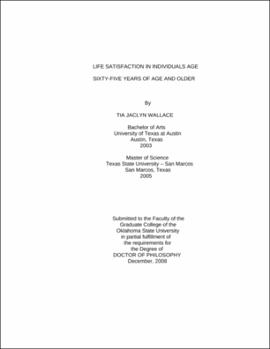| dc.contributor.advisor | Jacobson, Bert | |
| dc.contributor.author | Wallace, Tia Jaclyn | |
| dc.date.accessioned | 2013-11-26T08:34:59Z | |
| dc.date.available | 2013-11-26T08:34:59Z | |
| dc.date.issued | 2008-12 | |
| dc.identifier.uri | https://hdl.handle.net/11244/7610 | |
| dc.description.abstract | Scope and Method of Study: The purpose of this educational research study was to investigate whether various variables (exercise, ethnicity, gender, socioeconomic status, and retirement) had an effect on the quality of life in individual's age 65 years of age and older. The sample consisted of 793 participants (407 males and 386 females), living in the Greater Oklahoma City area, who were enrolled in the SecureHorizons healthcare plan. The SF-36v2 Health Survey calculated physical component summary scores, as well as mental component summary scores. These scores were then used to find significance in SPSS. | |
| dc.description.abstract | Findings and Conclusions: Independent t-tests revealed significant differences between low exercisers and high exercisers' physical component and mental component life satisfaction scores (SF-36v2); physical component scores (t = -41.179, df = 736.41, p = .000) and the mental component scores (t = -63.804, df = 718.15, p = .000). An analysis of variance revealed significant differences between group physical component and mental component life satisfaction scores (SF-36v2) for different ethnic backgrounds; physical component scores (F = 12.978, df = 4, p = .000) and the mental component scores (F = 15.156, df = 4, p = .000). Comparison of the means (± SE) revealed no significant differences between male and female physical component and mental component life satisfaction scores (SF-36v2); physical component scores (t = -.879, df = 791, p = .380) and the mental component scores (t = -.270, 791, p = .787). An analysis of variance revealed significant differences between group physical component and mental component life satisfaction scores (SF-36v2) among different income levels; physical component scores (F = 24.561, df = 4, p = .000) and the mental component scores (F = 24.741, df = 4, p = .000). Comparison of the means (± SE) revealed significant differences between retired individuals and individuals who are not retired physical component and mental component life satisfaction scores (SF-36v2); physical component scores (t = 9.487, df = 791, p = .000) and the mental component scores ( t = 11.135, df = 791, p = .000). One's exercise level, ethnic background, income level and retirement status all play a role in life satisfaction levels. However, no differences were found between males and females. | |
| dc.format | application/pdf | |
| dc.language | en_US | |
| dc.rights | Copyright is held by the author who has granted the Oklahoma State University Library the non-exclusive right to share this material in its institutional repository. Contact Digital Library Services at lib-dls@okstate.edu or 405-744-9161 for the permission policy on the use, reproduction or distribution of this material. | |
| dc.title | Life satisfaction in individuals age sixty-five years of age and older | |
| dc.contributor.committeeMember | Smith, Doug | |
| dc.contributor.committeeMember | Harris, Ed | |
| dc.contributor.committeeMember | Edwards, Steve | |
| osu.filename | Wallace_okstate_0664D_10068.pdf | |
| osu.accesstype | Open Access | |
| dc.type.genre | Dissertation | |
| dc.type.material | Text | |
| dc.subject.keywords | exercise | |
| dc.subject.keywords | life satisfaction | |
| dc.subject.keywords | senior adults | |
| thesis.degree.discipline | Teaching and Curriculum Leadership | |
| thesis.degree.grantor | Oklahoma State University | |
